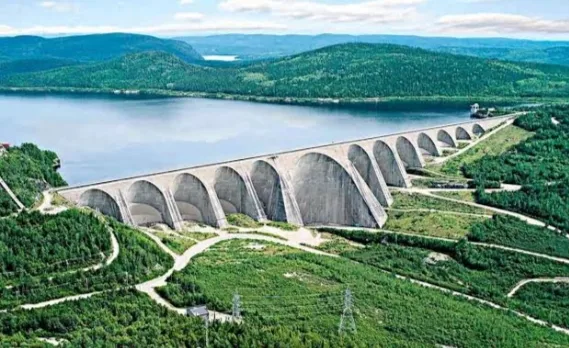Hydropower: Canada's Clean Energy Powerhouse
Canada, with its vast network of rivers and abundant freshwater resources, is a global leader in the production of hydroelectricity.
It stands tall as the fourth-largest producer in the world, behind only China, Brazil, and the United States. This reliance on hydro power has provided Canada with a clean and renewable energy source, contributing significantly to its low carbon footprint.
Hydropower Capacity in Canada: A Clean Energy Leader
Canada, with its vast network of rivers and lakes, is a global leader in hydropower generation. Here's a table summarizing the key aspects of hydropower capacity in Canada:
| Factor | Description |
|---|---|
| Hydroelectric Potential | Canada has an estimated hydroelectric potential of around 86,000 megawatts (MW). |
| Installed Capacity | As of 2023, the total installed hydroelectric capacity in Canada is around 60,000 MW, representing approximately 60% of the country's total installed power capacity. |
| Largest Hydropower Plants | Some of the largest hydroelectric power plants in Canada include: |
* James Bay Project (Quebec)
* Churchill Falls Generating Station (Labrador)
* Alcan Dam (British Columbia)
| Energy Exports | Canada is a significant exporter of hydropower to the United States, particularly in the northwestern regions. | | Challenges | The development of hydropower projects in Canada faces challenges such as: * Environmental Impacts: Hydropower projects can have significant environmental consequences, including habitat destruction and impacts on aquatic ecosystems. * Social Issues: The construction of dams often displaces communities and can lead to social conflicts. * Economic Dependence: Overreliance on hydropower can make Canada vulnerable to fluctuations in water availability and energy demand.
Note: The data in this table may vary slightly due to ongoing developments and updates in Canada's energy sector. For the most accurate and up-to-date information, please refer to official sources from the Canadian government or energy agencies.
Harnessing the Power of Water: How Hydroelectricity Works
Hydroelectric power plants convert the kinetic energy of moving water into electricity. This is achieved through a series of steps:
- Dam construction: Dams are built across rivers to create reservoirs, storing water and controlling its flow.
- Water flow: Water is released from the reservoir through tunnels or pipes, gaining speed as it falls.
- Turbine rotation: The rushing water hits the blades of a turbine, causing it to rotate.
- Electricity generation: The rotating turbine shaft is connected to a generator, which converts the mechanical energy into electricity.
- Transmission and distribution: The generated electricity is transmitted through power lines to homes, businesses, and industries.
Canada's Hydropower Landscape: A Statistical Overview
Here's a glimpse into the current state of hydroelectricity in Canada:
- Installed capacity: Over 81 Gigawatts (GW) of installed capacity, spread across more than 500 hydroelectric facilities. (Source: Waterpower Canada)
- Electricity generation: Hydropower accounts for approximately 60% of Canada's electricity generation, with the remaining share coming from other sources like nuclear, wind, and solar. (Source: Canadian Hydropower Association)
- Regional distribution: Quebec leads the pack with over 95% of its electricity generated from hydro, followed by Newfoundland and Labrador, Manitoba, and British Columbia. (Source: Canadian Hydropower Association)
- Economic impact: Hydropower contributes significantly to the Canadian economy, supporting over 65,000 jobs and generating billions in revenue. (Source: Waterpower Canada)
Table 1: Hydropower Capacity and Generation by Province (Source: Canadian Hydropower Association)
| Province | Installed Capacity (MW) | Hydroelectric Generation (TWh) | Share of Provincial Generation (%) |
|---|---|---|---|
| British Columbia | 15,929 | 65.0 | 85.9 |
| Alberta | 2,053 | 8.9 | 11.7 |
| Saskatchewan | 5,052 | 34.9 | 98.5 |
| Manitoba | 5,320 | 37.9 | 99.5 |
| Ontario | 10,587 | 84.3 | 61.3 |
| Quebec | 36,325 | 206.2 | 96.4 |
| New Brunswick | 2,611 | 10.9 | 63.9 |
| Nova Scotia | 1,305 | 5.4 | 82.1 |
| Newfoundland & Labrador | 8,034 | 35.4 | 92.0 |
| Yukon | 135 | 5.6 | 99.9 |
| Northwest Territories | 469 | 4.4 | 99.3 |
| Nunavut | 4 | 0.0 | 0.0 |
Note: MW = Megawatts, TWh = Terawatt-hours
Advantages and Challenges of Hydropower
Advantages:
- Clean and renewable: Hydropower produces minimal greenhouse gas emissions, making it a crucial resource in combating climate change.
- Reliable and baseload: Hydropower plants can operate continuously, providing a stable and reliable source of electricity.
- Energy storage: Reservoirs can store potential energy, allowing for flexible generation to meet peak demand periods.
- Economic benefits: Hydropower creates jobs, generates revenue, and supports economic development in remote regions.
Challenges:
- Environmental impacts: Dam construction can disrupt ecosystems, displace communities, and affect water quality and flow.
- High upfront costs: Building dams and power plants requires significant investment and long construction times.
- Social and cultural impacts: Indigenous communities and traditional ways of life can be affected by hydropower projects.
- Geographical limitations: Not all regions have suitable geographical features for large-scale hydropower development.
Future of Hydropower in Canada
Canada's vast hydropower potential still remains largely untapped, particularly in northern provinces like Quebec and British Columbia. As the country strives to achieve net-zero carbon emissions by 2050, hydropower is expected


